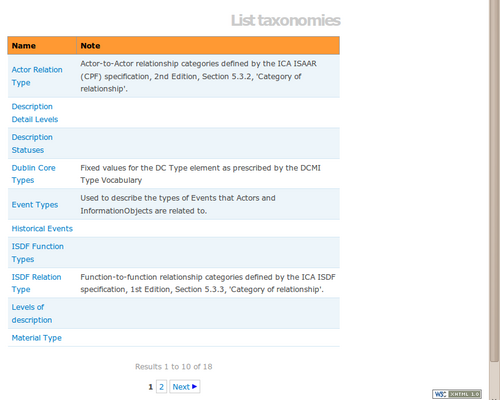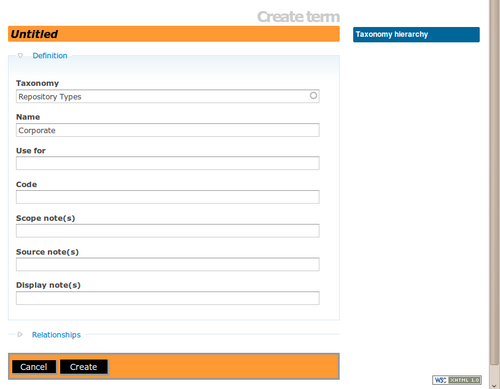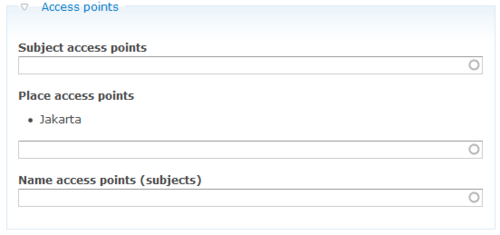Add a new term
Please note that ICA-AtoM is no longer actively supported by Artefactual Systems.
Visit https://www.accesstomemory.org for information about AtoM, the currently supported version.
Main Page > User manual > Add/edit content > Add/edit terms > Add a new term
From the Manage Taxonomy Screen
- Click Manage > Taxonomies in the main menu to go to a list of taxonomies. ICA-AtoM takes you to the taxonomy terms list page showing all existing taxonomies.
- Click the taxonomy you want to edit to expand it and view the terms associated with it.
- Click the Add new button to add a new term to the taxonomy. This will open the edit page for data entry.
- See Term data entry for detailed explanations and notes on fields.
- You can quit the cancel the process at any time by clicking the "cancel" button in the button block; no new term will be created.
- Click the Create button to save the new record.
Adding Access points to archival descriptions
Adding Access points "on the fly" from archival descriptions screen:
Access points can be added by users with edit permissions on the fly (without leaving an archival description) from the add/edit archival descriptions screen by simply adding a new name, subject, or place to the corresponding field in the Access points area.
Any terms previously created and any access point taxonomies already imported into ICA-AtoM will populate a the drop-down menu when a user places the cursor in the field, to ensure that controlled vocabulary terms are maintained, but multiple new terms can also be added. However, if a hierarchical relationship is to be established between terms (for example, nesting "Mount Pleasant" as a narrower term of "Vancouver"), an administrator or editor will have to edit the term through the taxonomies list.
On Name vs. Subject Access Points
Name access points provide linked access to information about actors associated with an archival description – either as creators, or as subjects, or via other types of relation (including contributor, publisher, collector, distributor, etc.). The type of relationship of a name access point to an archival description can be managed via the ISAAR-CPF authority record template for that name (which the user is directed to when clicking on the name access point in an archival description).
Name (creator) access points are automatically derived from ISAAR authority records in AtoM. Doing so conforms to the recommendations found in ISAAR-CPF 1.5 and 1.6, and 1.8:
1.5 There are many reasons why separate capture and maintenance of this type of contextual information is a vital component of archival description. The practice enables the linking of descriptions of records creators and contextual information to descriptions of records from the same creator(s) that may be held by more than one repository and to descriptions of other resources such as library and museum materials that relate to the entity in question. Such links improve records management practices and facilitate research.
1.6 Where a number of repositories hold records from a given source they can more easily share or link contextual information about this source if it has been maintained in a standardized manner. Such standardization is of particular international benefit when the sharing or linking of contextual information is likely to cross national boundaries. The multinational character of past and present record keeping creates the incentive for international standardization which will support the exchange of contextual information. For example, processes such as colonialization, immigration and trade have contributed to the multinational character of recordkeeping.
1.8 Archival authority records are similar to library authority records in as much as both forms of authority record need to support the creation of standardized access points in descriptions. The name of the creator of the unit of description is one of the most important of such access points. Access points may rely on the use of qualifiers that are deemed essential to clarify the identity of the entity thus named, so that accurate distinctions may be made between different entities that have the same or very similar names.
By generating a creator name access point from an authority record, AtoM thereby supports the linking of archival descriptions related by creator by using a standardized name (as access point) drawn from the authority record. Clicking on a name access point in an archival description will bring a user to the AtoM ISAAR-CPF Authority Record for the name. Name entity types can be defined in the authority record as either a person, a family, or corporate body.
AtoM also allows users to add new name access points on the fly, so other important names can be associated with an archival description. When a user adds a name access point, a new authority record for the added entry is generated, and the access point is automatically listed with the qualification of “(subject)” next to the link, for added clarity about the role of the named entity. Authorized users (e.g., authenticated editors or administrators, etc.) can then add descriptive contextual information to the authority record. If an added name is the creator of another fonds/collection in AtoM, this relationship can be defined through the authority record, just as relationships between other entities can be defined as either hierarchical, temporal, associative, or family. Similarly, the relationship to the linked archival description can be managed by defining the Nature of relationship in the Relationships Area of the Authority record.
In contrast, Subject access points are managed via the Taxonomies, and are intended to add topical information about events, objects, etc. covered in the materials of a fonds/collection, allowing users to gain a sense of the topics covered therein, obtain better search results, and easily view other archival descriptions that contain materials on the same subject. Clicking on a subject access point will bring the user to a search results page, displaying summary descriptive information about descriptions that also contain the same subject access point. Authorized users (ex: editors, administrators) can add subject access points on the fly straight from the archival description edit page, and they can provide descriptive summaries and manage hierarchical relationships of the access point by navigating to Manage > Taxonomies > Subjects.
In summary, Name access points support ISAAR-CPF’s requirements, and can be thought of as similar to the 245$c, 700, 710, 600, and 610 fields in a library MARC record (depending on the type of relationship, as defined in the authority record). In contrast, Subject access points relate to topical information and general subject terms, similar to the 650 field in a library MARC record.


